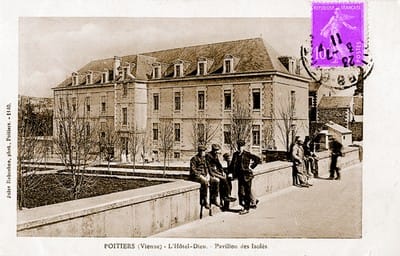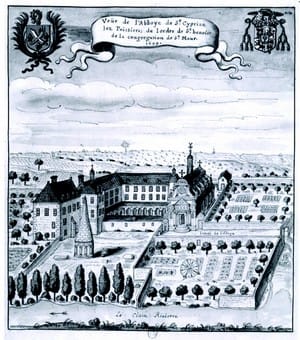Some history
Legal status
The hospital complex of Poitiers is, given its specializations, a regional hospital center, as well as a university hospital center since 20 February 1961.
In accordance with a 30 December 1958 ordinance, the CHU is a public health establishment whose public service mandates are missions of curative and palliative care, and of prevention, teaching and research.
Pursuant to the French “Hospital, patient, health and territory” law, the Poitiers CHU is administered by a management board headed by Jean-Pierre Dewitte, managing director and a supervisory board of which the president is Alain Claeys, deputy and mayor of Poitiers.
Historical development
The history of the hospital center got underway prior to 1200 with the foundation of the Notre-Dame-la-Grande chaplaincy in front of the church with the same name.
In the early 16th century, the municipality decided to transform the chaplaincy, converting it into the Hôtel Dieu, also known as the hospital for patients in the town of Poitiers. Only a century later was the Hôpital général created for the town’s paupers and elderly persons; it is presently located on rue Jean Macé.
The Hôtel-Dieu
 At the time of its creation, Hôtel-Dieu-Notre-Dame contained only twenty beds. Too small and too inconveniently situated face to the town market, it soon had no choice but to raise money for a necessary move. For a number of reasons, the move unfortunately never took place, and the Hôtel-Dieu had no choice but to enlarge its existing facilities. By the end of the 18th century, on-site expansion had enabled the establishment to contain one hundred beds. Today this building still exists, and it houses the Poitiers Faculty of Law.
At the time of its creation, Hôtel-Dieu-Notre-Dame contained only twenty beds. Too small and too inconveniently situated face to the town market, it soon had no choice but to raise money for a necessary move. For a number of reasons, the move unfortunately never took place, and the Hôtel-Dieu had no choice but to enlarge its existing facilities. By the end of the 18th century, on-site expansion had enabled the establishment to contain one hundred beds. Today this building still exists, and it houses the Poitiers Faculty of Law.
During the Vendée wars, numerous confiscations of religious edifices allowed Hôtel Dieu to move into the buildings of a one-time major seminary: Hôtel Pinet, which now houses the headquarters of the University of Poitiers. The establishment then became a civil and military hospital with a capacity of 300 beds, and the capacity stagnated at that level until the middle of the 19th century.
Thereafter, new units opened up with the creation of the maternity hospital, the school of medicine, the contagious disease pavilion and the sanatorium, and parts of the Dalesmes barracks were commandeered to further the development of health care activities.
During the 1960s, Hôtel-Dieu became a regional university center, a milestone in the history of the hospital. And sooner rather than later, Hôtel Dieu was no longer large enough, so it decided to relocate on what was then the largely empty Milétrie site.
The La Milétrie hospital
 During the 1930s, the Vienne department acquired the La Milétrie property to build a psychiatric hospital. After having been suspended due to World War II, only in 1950 was the project followed up.
During the 1930s, the Vienne department acquired the La Milétrie property to build a psychiatric hospital. After having been suspended due to World War II, only in 1950 was the project followed up.
Over the following decades, several hospital pavilions were built in the western part of the property:
- René-Le-Blaye in 1954;
- Camille-Guérin in 1965;
- René-Beauchant, Georges-Heuyer, Joseph-Garnier and the nursing school;
- The Jean-Bernard “tower” in 1980.
Over the last twenty years, new extensions such as the Etablissement français du sang (EFS: French blood institute) have seen the light of day, and the satellite accommodating the surgical intensive care and medical intensive care units will be opening soon.
As regards the René-Beauchant pavilion, its expansion has led to the constitution of a heart and lung center, which meets an undeniable need for care and treatment facilities in this field.
In January 2006, a new building was put into operation. Known in French as UBM (Emergencies and medical biology), it brings together the adult, pediatric and SAMU-SMUR emergency services, the emergency call center (15) as well as medical biology facilities accommodating all relevant laboratories.
In March 2009, the regional cancerology center opened; its area totals 13000 m², and it contains four levels with a capacity of 135 beds and places for treatment.
In 2006, the Georges-Heuyer building was renamed Camille-Claudel. Opened in 1970, this 106-bed building was initially designed to accommodate maladjusted children and severely disabled people. Having been thoroughly restructured, it currently hosts two post-acute care and rehabilitation units as well as a geriatric day hospital.
In 2009, three different factors induced the geriatric center to propose a new nomenclature for the buildings henceforth reserved for treatment of ailing elderly persons:
- the wish to provide the building with a new orientation;
- the exclusive dedication of the Maurice-Salles pavilion to geriatrics;
- the construction of a new, 141-bed building, replacing the ancient Pasteur hospital..
The buildings affected by the changed designation are the following:
- Camille-Claudel;
- Auguste-Rodin (for use of part of the Maurice-Salles building);
- Aristide-Maillol (opened in May 2011).
The general hospital
Created in 1657, its mission consisted in “confining” the indigent. The hospital was also tasked with succoring abandoned children and invalid elderly persons.
Given these different missions, the hospital accommodated more than 700 people during the 18th-century famines.
By the end of the French Revolution, the general hospital was no longer a prison environment but remained devoted to social welfare (it still welcomed abandoned children and the elderly) and began to provide health services for the mentally unfit. It closed in 1927, and the “alienated” persons were temporarily transferred to the Pasteur facilities. In 1937, it resumed its activities, functioning as a safe home for refugees from the Spanish Civil War. In 1940, it recovered its health service vocation with the arrival of patients from hospitals in the Moselle area.
The geriatric hospital Louis Pasteur
 In the middle of the 18th century, in the Faubourg du Pont-Neuf district, the Hôpital des Incurables de la Province du Poitou was created under the aegis of Père Grignion de Monfort and l’Emery d’Echoisy, Grand Prior of Aquitaine. The hospital’s mission consisted in caring for the incurably ill, who were not accepted for admission to other hospitals. As it had more room for expansion than the general hospital, it gradually took on the functions of the latter, and came to occupy the one-time properties of Saint Cyprien abbey, of which the buildings had been demolished during the French Revolution, leaving space for the Jardin des Plantes (botanical gardens) and a silk farm known as a magnanery. In 1870, when the Jardin des Plantes was set up at its present-day site, the Dominicans built a convent in the gardens, from which they were expelled in 1901 due to the French law restricting the installation of religious congregations. Initially occupied by the army, the former convent was purchased by the Hospices in 1922, thereby enabling it, a few years later, to close the general hospital. During the same year, the Hôpital des Incurables relinquished its name in favor of Louis-Pasteur, of which the centenary was celebrated in the same year.
In the middle of the 18th century, in the Faubourg du Pont-Neuf district, the Hôpital des Incurables de la Province du Poitou was created under the aegis of Père Grignion de Monfort and l’Emery d’Echoisy, Grand Prior of Aquitaine. The hospital’s mission consisted in caring for the incurably ill, who were not accepted for admission to other hospitals. As it had more room for expansion than the general hospital, it gradually took on the functions of the latter, and came to occupy the one-time properties of Saint Cyprien abbey, of which the buildings had been demolished during the French Revolution, leaving space for the Jardin des Plantes (botanical gardens) and a silk farm known as a magnanery. In 1870, when the Jardin des Plantes was set up at its present-day site, the Dominicans built a convent in the gardens, from which they were expelled in 1901 due to the French law restricting the installation of religious congregations. Initially occupied by the army, the former convent was purchased by the Hospices in 1922, thereby enabling it, a few years later, to close the general hospital. During the same year, the Hôpital des Incurables relinquished its name in favor of Louis-Pasteur, of which the centenary was celebrated in the same year.
Psychiatric patients were treated in this hospital until 1950, when they were transferred to the pavilions of La Milétrie.
In 1970, the psychotherapy center of the Vienne department was legally separated from the CHU, and became the Centre hospitalier Henri-Laborit.
Over recent years, the Louis-Pasteur hospital has undergone sweeping changes, punctuated by the closing of its 18th-century facilities and reorganization on the Milétrie site of the geriatric center’s activities.
In May 2011, the transfer to the Milétrie of medical activities in geriatrics, now directed by the CHU of Poitiers, marked a major turning point in the history of the former site of the Louis-Pasteur hospital, which is being replaced by building projects, expanded student lodgings and two establishments accommodating the elderly, in what has become a genuine neighborhood between the Pont-Neuf and Pont-St-Cyprien neighborhoods of Poitiers.
